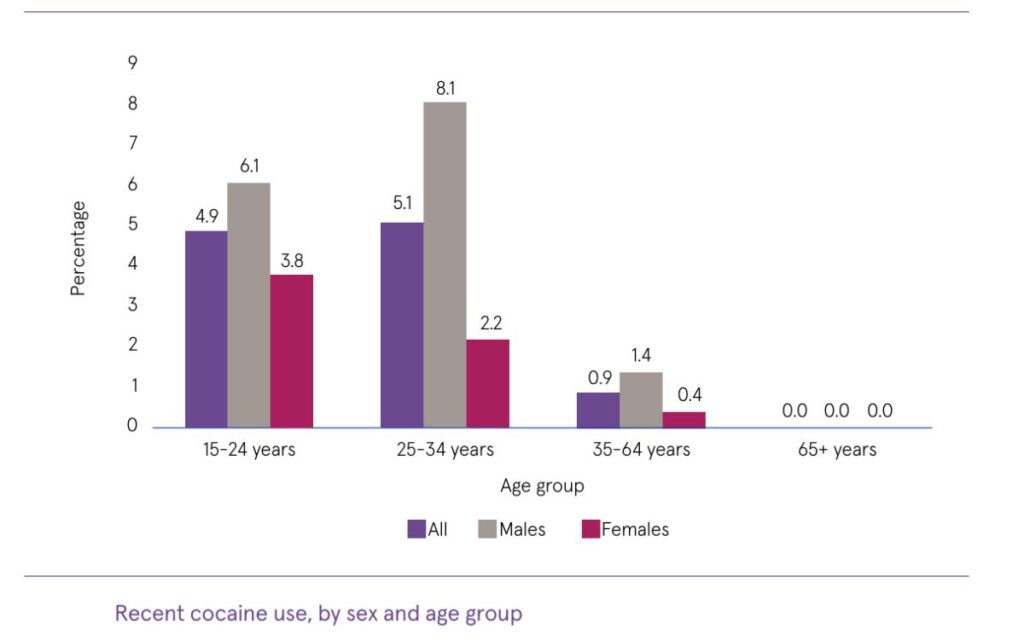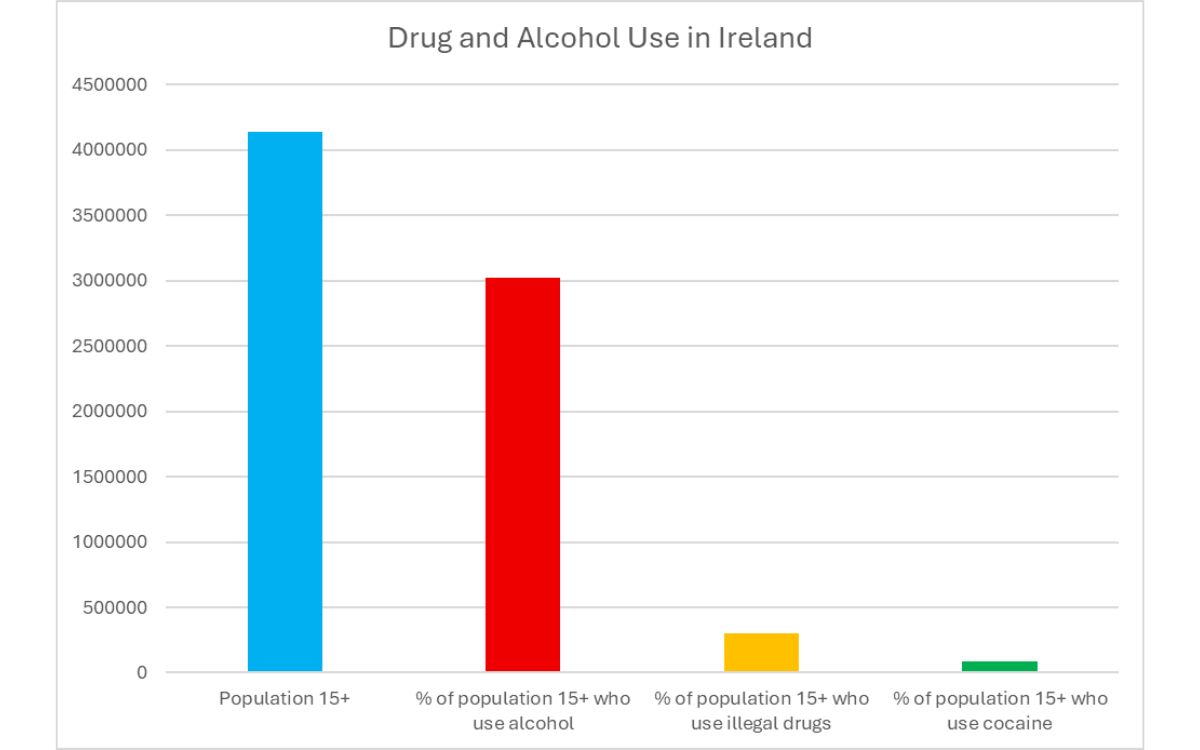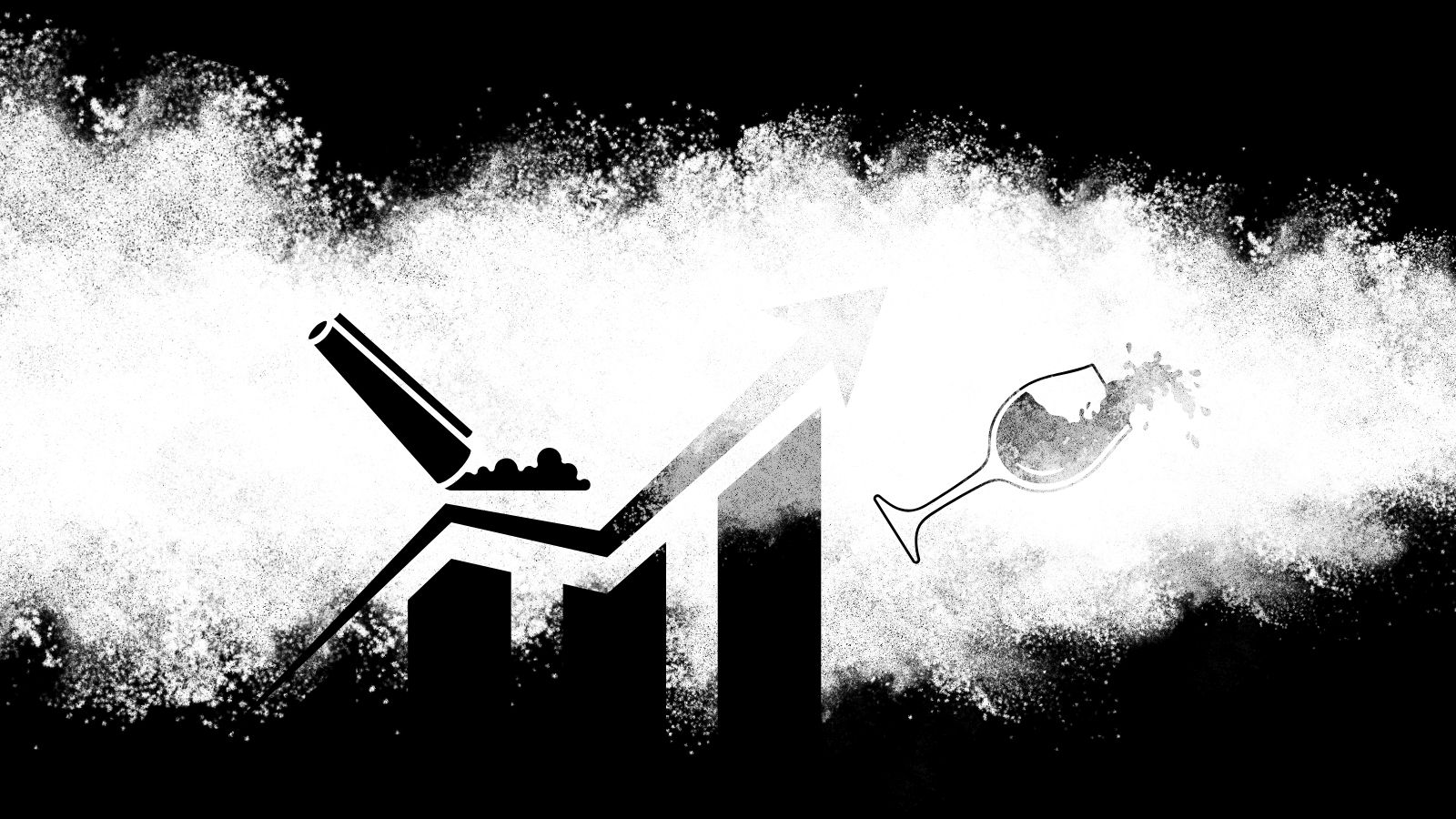No evidence to claim Irish people are substituting cocaine for alcohol
Recently, provisional datasets from Ireland’s Revenue Commissioners indicated that alcohol consumption had decreased slightly to 9.45 litres per capita over the age of 15 years in 2024.[1] For many, this decrease was a welcome development and an affirmation that public health measures were moving in the right direction, and with renewed focus from government could reach the modest reduction target of 9.1 litres per capita which was set in 2013, to be achieved by 2020.[2] While consumption levels are still 35% above HSE lower risk drinking guidelines, the platform is there to achieve Ireland’s, and the HSE’s, stated public health aims with the necessary political will and policy decisions.
However, for some this slight decrease was, in fact, a worrying development, while for others the success of the health policies which have helped reduce consumption, and thereby achieve better public health and reduce harms, was evidence that these policies should be reversed.
Cue two opinion-pieces in national newspapers last week articulating the view that a decrease in alcohol consumption was leading to an increase in cocaine use amongst the Irish public.[3] [4] While it makes for an interesting and salacious topic, it is logical fallacy. There is no evidence to claim that decreasing alcohol consumption is leading to increasing cocaine consumption. Nor is there a modicum of evidence to suggest that the two events are linked – as any schoolchild can tell you, correlation does not imply causation. More worryingly, Taoiseach Micheál Martin was dragged into the correlation-without-causation fallacy when a journalist asked for his views on the matter, saying that he believed there “could very well be a link”.[5]
It must be stated at the outset that not only is there not a causation between a decrease in alcohol consumption and an increase in cocaine consumption, but findings from the Health Research Board published on the day of the Taoiseach’s comments revealed only a negligible population level increase in cocaine use in Ireland. The results of the Healthy Ireland ‘Drug use in Ireland 2023’ reported that cocaine use now stands at 2.0% of the population over 15, or about 83,000 people, which is similar to 2019–20 levels (1.9%).[6] For comparison, 73% of the population over 15, about 3,020,000 people, drink alcohol – Ireland’s most widely consumed drug. [7]

HRB StatLink Series 25: ‘Drug use in Ireland 2023’, Findings from the Healthy Ireland Survey – published July 2025 [8]
Cocaine is not cheaper than alcohol
As he opens his opinion-piece in the Business Post, Matt Cooper repeatedly says there is ample evidence to suggest that a decrease in alcohol consumption due to price increases has led to an increase in cocaine use. Surprisingly, despite the article running to nearly 2,000 words, he never provides nor references this evidence. Mr Cooper, however, is wrong on both assertions. Despite what people may feel or believe, rigorous research has highlighted that alcohol is, in fact, more affordable that ever; while there is no factual evidence that decreasing alcohol consumption is leading to increasing cocaine use.
While Mr Cooper is entitled to his own opinion he is not entitled to his own facts. There is a difference between price and affordability, with price being the actual cost of something, while affordability is the extent to which a person or household can comfortably afford that cost. A large body of international research evidence has demonstrated the influence that income plays in the affordability of alcohol.[9] Comprehensive research from the University of Sheffield using data from the Central Statistics Office indicates that shop-bought alcohol today in Ireland is around the same price that it was 20 years ago, with the introduction of Minimum Unit Pricing (MUP) in 2022 only bringing it back to 2003 levels.[10] Indeed, as of 2024 alcohol bought in the on-trade is 23.9% affordable than in 2004, while off-trade affordability is 84.8% higher.[11]

Updated analysis of changes in alcohol sales, prices, taxation and affordability in the Republic of Ireland [12]
Furthermore, it cannot be said often enough – MUP has no impact on the price of a pint in a pub, or any alcohol sold in pubs, clubs, or restaurants. MUP targets the cheapest and strongest alcohol sold in the off-trade – that is, off-licences, shops, supermarkets, and so on. As evidenced above, alcohol in off-licences and pubs is more affordable now than it was 20 years ago. MUP is a solution, not a problem. MUP targets the harmful drinking of cheap, strong alcohol – this sort of alcohol consumption causes significant health, social, and economic problems – the payment for which is borne by the taxpayer. Therefore, as MUP reduces these harms, it saves taxpayers money.

Updated analysis of changes in alcohol sales, prices, taxation and affordability in the Republic of Ireland [13]
So, does Mr Cooper really expect anyone to believe that “further increases in the price of alcohol might drive more people to use the cheaper illegal drug [cocaine] in greater quantities.”?
Earlier this year the Minister for Justice indicated that the current market value for cocaine was €70 per gram[14] while research from the Irish Independent put the national average price for a pint of stout at €5.83 and €6.20 for a pint of lager. Are we to believe that people are forgoing paying €6 for a pint on a night out and instead switching to cocaine because it’s “cheaper” at €70 a gram? Such an argument simply does not make sense. This is supported by academic evidence which indicates that alcohol consumption, and not a lack thereof, drives cocaine use.[15] [16] [17] [18] [19]
Alcohol is known to increase cravings for cocaine, therefore creating a cycle of misuse of both.[20] Evidence of this can be seen from the last Irish National Drug and Alcohol Survey which found that 84.9% of lifetime users of cocaine also used alcohol on the occasion of first use.[21] This is reinforced by more recent work from the Health Research Board which shows that in 2024 the most common additional drug alongside powder cocaine was alcohol (63.9%).[22] This tallies with international research which indicates that that 60–85% of problematic users of cocaine are also concurrent problematic users of alcohol, and that simultaneous consumption is common.[23] Indeed, further research shows that a diagnosis of alcohol dependence may be made in 50%-90% of cocaine-dependent subjects.[24]
The comorbid abuse of these drugs increases euphoria and enhances the perception of overall state of well-being, and these psychological effects encourage ingestion of larger amounts of cocaine and alcohol.[25] The reason being cocaine produces its psychoactive and addictive effects primarily by acting on the brain’s limbic system, a set of interconnected regions that regulate pleasure and motivation. It rapidly enters the bloodstream and penetrates the brain, and the drug achieves its main immediate psychological effect – the high – by causing a buildup of the neurochemical dopamine which gives rise to euphoria and a desire to take the drug again.[26] [27] However, the high from consuming the drug may only last 15 to 30 minutes, therefore, further use is necessitated to maintain its euphoric effects.[28] Therefore, alcohol consumption and repeated cocaine intake over the course of a night makes cocaine use a costly habit.
Cocaine related harm is a significant issue in Ireland, but there has been a recent tendency for media commentators and the alcohol industry to overestimate the use of the drug to the deliberate exclusion of alcohol use and harm, rather than dealing with both with the seriousness they deserve. This is reinforced by findings from the Health Research Board published on 2nd May 2025 into drug use in Ireland. The Healthy Ireland Survey into ‘Drug use in Ireland 2023’ reported that cocaine use stands now stands at 2.0%, which is similar to 2019–20 levels (1.9%)[29] and United Nations data for 2019, 2.4%.[30]
Indeed, the research revealed that in 2023, 7.3% of the adult population, approximately 301,000 people, reported using an illicit drug in the past year.[31] However, according to the Healthy Ireland survey 2024 approximately 73% of the population over 15 drink alcohol – Ireland’s most widely consumed drug. [32] Such levels of consumption have obvious harms, and approximately 15% of the population has an Alcohol Use Disorder (AUD), 570,000 people, with 90,000 at a severe level. However, in 2023, only 8,164 alcohol cases[33] were treated compared with 13,104 cases[34] of illegal drug treatment cases, despite the overwhelming prevalence of AUD in Ireland compared with illegal drug use.
The results of the Healthy Ireland ‘Drug use in Ireland 2023’ reported that cocaine use stands now stands at 2.0% of the population over 15 or about 83,000 people, which is similar to 2019–20 levels (1.9%).[35] For comparison, 73% of the population over 15, about 3,020,000 people, drink alcohol – Ireland’s most widely consumed drug. [36]

Calls to reverse public health policy are nonsense
In conjunction with claiming the price of alcohol is driving people to consume cocaine, the opinion-pieces also took aim at Ireland’s alcohol excise rates, with some claiming that the reduction in per capita alcohol consumption rates to the average European level was a good argument for reducing alcohol excise taxes. This argument, however, ignores two realities. Europe is the area with the highest alcohol consumption per capita globally, so the European average is disproportionately high, while controls on pricing is a key public policy measure to regulate demand for alcohol as affordability is an important driver in the growth of alcohol consumption. Put simply, alcohol is price sensitive – increasing the cost of alcohol reduces its consumption and decreasing the cost of alcohol increases its consumption.[37] Therefore, alcohol taxes play an important role in reducing consumption and thereby harms, because we can say with some confidence that more drinking tends to result in more harm, and less drinking tends to result in less harm.[38]
The alcohol industry likes to point to other taxation which they pay such as VAT and employment taxes. However, all industries pay these, but it is important to distinguish between health harming products such as alcohol and tobacco and regular commodities. The imposition of excise duties is a reflection of their specific harmful nature. Moreover, as it stands, industry excise duties do not even come close to compensating for the harm their product costs the State, and by extension, the taxpayer.
The OECD estimates that for Ireland the costs of alcohol harm are of the order of about 1.9% of GDP[39] which tallies with research cited by the World Health Organisation that in high income countries alcohol harm amounts to up 2.5% of GDP.[40] That would equate to approximately €9.6bn-€12bn annually. Against that alcohol excise duties only raise €1.2bn annually. This is why Ireland must take a public health approach to taxation, one that recognises and accounts for the heavy burden alcohol places on public finance and spending.
Seeking to reduce excise duties because alcohol consumption has slightly decreased would be akin to increasing speed limits because there were fewer road collisions. Such a move would see harms increase and the State picking up the tab. The opportunity cost of this is less money to invest in much needed areas such as treatment for alcohol and drug addiction.
Conclusion
So, who benefits from false claims that decreasing alcohol consumption is leading to increasing cocaine consumption? Well for a start it deflects attention away from what is by far Ireland’s largest drug problem, alcohol. The 2024 Healthy Ireland survey found that 73% of the population over 15 consume alcohol,[41] with 2025 data from the HRB indicating that 2% use cocaine – a level that has remained steady since the 2019-2020 Drug and Alcohol Survey.[42]

HRB research indicates that around half of all who drink are ‘hazardous drinkers.’[43] In fact Ireland has the 8th highest level of such binge drinking in the OECD[44] and this rate has risen in the past year.[45] It may be a surprise to some but as a result of these drinking patterns the majority of alcohol-related harms in the population are accounted for by low- to moderate-risk drinkers, particularly those who engage in occasions of binge drinking.[46]
Furthermore, the idea that young people are avoiding alcohol en masse is another argument which does not stack up. Data from the HRB shows that 75% of 15–24-year-olds consume alcohol[47] and only last month Diageo’s global consumer planning director, said: “A lot of people talk about Gen Z being a cohort that is moving away from alcohol. Our data tells us otherwise. While they drink socially a little less frequently than other cohorts, they do so very enthusiastically.”[48] In the Irish context ‘enthusiastically’ could be replaced with ‘dangerously’ given Healthy Ireland survey data shows that 38% of 15-24-year-olds binge drink on a typical drinking occasion,[49] and more than two-fifths of 25-year-old Irish men and a third of women are drinking at levels the World Health Organization classifies as ‘hazardous’.[50]
There is certainly no reason to be complacent about cocaine use in Ireland. However, it does not follow that Ireland has no issue with alcohol. It serves nobody, bar the alcohol industry, any good to pit cocaine against alcohol, as if it is a binary choice between addressing the harms of one or the other. Both are drugs, which are often used in combination, and cause serious harm to our society and economy, and it is important that those who have a platform to address these issues do so accurately and with the necessary facts, not feelings or anecdotes.
[1] https://www.irishtimes.com/ireland/social-affairs/2025/06/09/irish-people-consuming-alcohol-at-european-average-with-45-drop-last-year-figures-show/
[2] https://www.drugsandalcohol.ie/40465/1/HRB_Alcohol_overview_series_13.pdf
[3] https://www.irishtimes.com/opinion/2025/06/23/una-mullally-ireland-is-becoming-a-country-of-moderate-drinkers-and-voracious-cocaine-users/
[4] https://www.businesspost.ie/uncategorized/matt-cooper-drinks-industry-left-dizzy-by-contradictory-and-incoherent-law-changes/
[5] https://www.thejournal.ie/taoiseach-says-there-could-be-link-between-falling-alcohol-consumption-and-increased-drug-use-6750034-Jul2025/
[6] https://www.hrb.ie/wp-content/uploads/2025/07/Findings-from-the-Healthy-Ireland-Survey-FINAL.pdf
[7] https://www.hrb.ie/wp-content/uploads/2024/05/The_2019-20_Irish_National_Drug_and_Alcohol_Survey._Main_findings-1.pdf
[8] https://www.hrb.ie/wp-content/uploads/2025/07/Findings-from-the-Healthy-Ireland-Survey-FINAL.pdf
[9] https://orda.shef.ac.uk/ndownloader/files/52854602
[10] https://orda.shef.ac.uk/ndownloader/files/52854602
[11] https://orda.shef.ac.uk/ndownloader/files/52854602
[12] https://orda.shef.ac.uk/ndownloader/files/52854602
[13] https://orda.shef.ac.uk/ndownloader/files/52854602
[14] https://www.oireachtas.ie/en/debates/question/2025-01-22/1064/
[15] https://www.tandfonline.com/doi/abs/10.1080/09687630110112609
[16] https://www.sciencedirect.com/science/article/abs/pii/S0376871618304885
[17] https://academic.oup.com/alcalc/article/58/3/274/7042579
[18]https://journals.lww.com/journaladdictionmedicine/abstract/2013/05000/onset_of_cocaine_use__associated_alcohol.5.aspx
[19] https://www.sciencedirect.com/science/article/pii/S1752928X23001154#bbib35
[20] https://www.healthline.com/health/cocaine-and-alcohol#myth-busting
[21] https://www.drugsandalcohol.ie/34287/1/HRB_Irish_National_Drug_and_Alcohol_Survey_2019_20.pdf
[22] https://www.hrb.ie/wp-content/uploads/2025/05/Drug-treatment-bulletin-2024.pdf
[23] https://www.sciencedirect.com/science/article/pii/S0006322397004265
[24] https://pubmed.ncbi.nlm.nih.gov/19631491/
[25] https://www.sciencedirect.com/science/article/pii/S0006322397004265
[26] https://pmc.ncbi.nlm.nih.gov/articles/PMC2851032/
[27] https://pmc.ncbi.nlm.nih.gov/articles/PMC2851032/
[28] https://pmc.ncbi.nlm.nih.gov/articles/PMC9032145/
[29] https://www.hrb.ie/wp-content/uploads/2025/07/Findings-from-the-Healthy-Ireland-Survey-FINAL.pdf
[30] https://www.drugsandalcohol.ie/38406/
[31] https://www.hrb.ie/wp-content/uploads/2025/07/Findings-from-the-Healthy-Ireland-Survey-FINAL.pdf
[32] https://www.hrb.ie/wp-content/uploads/2024/05/The_2019-20_Irish_National_Drug_and_Alcohol_Survey._Main_findings-1.pdf
[33] https://www.drugsandalcohol.ie/41144/1/Alcohol_Treatment_2023_Bulletin.pdf
[34] https://www.hrb.ie/wp-content/uploads/2024/06/Drug_Treatment_2023_Bulletin.pdf
[35] https://www.hrb.ie/wp-content/uploads/2025/07/Findings-from-the-Healthy-Ireland-Survey-FINAL.pdf
[36] https://www.hrb.ie/wp-content/uploads/2024/05/The_2019-20_Irish_National_Drug_and_Alcohol_Survey._Main_findings-1.pdf
[37] https://www.drugsandalcohol.ie/19131/
[38] https://www.tandfonline.com/doi/abs/10.1080/146598901753325048
[39] https://www.oecd.org/en/publications/preventing-harmful-alcohol-use_6e4b4ffb-en.html
[40] https://iris.who.int/bitstream/handle/10665/374284/9789240082793-eng.pdf?sequence=1
[41] https://assets.gov.ie/static/documents/healthy-ireland-survey-summary-report-2024.pdf
[42] https://www.hrb.ie/wp-content/uploads/2025/07/Findings-from-the-Healthy-Ireland-Survey-FINAL.pdf
[43] https://www.hrb.ie/publication/alcohol-availability-affordability-related-harm-and-policy-in-ireland/
[44] https://www.oecd.org/en/publications/health-at-a-glance-europe-2024_b3704e14-en.html
[45] https://www.gov.ie/en/healthy-ireland/publications/healthy-ireland-survey-2024/
[46] https://bmcpublichealth.biomedcentral.com/articles/10.1186/s12889-019-7666-4
[47] https://assets.gov.ie/static/documents/healthy-ireland-survey-summary-report-2024.pdf
[48] https://www.theguardian.com/society/2025/jun/23/bacardi-breezers-to-buzzballz-why-gen-z-arent-booze-buzzkills
[49] https://assets.gov.ie/static/documents/healthy-ireland-survey-summary-report-2024.pdf
[50] https://www.newstalk.com/news/more-than-two-fifths-of-young-irish-men-drink-at-hazardous-levels-2158418

